Stories from Dominaria, Part 1
Dominaria is a world of stories. Dominaria, interestingly, is also a world of stories, some of which I'm going to get to tell over the next three weeks. So sit back as I begin telling the many card-by-card design stories of Dominaria.
Adeliz, the Cinder Wind
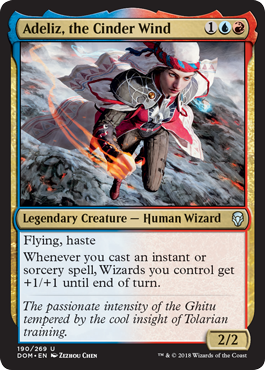
Back in 2000, I was tasked by Bill Rose to make a Magic website. Trying to follow all the things I had learned in communication school, I wanted to make sure that there was content that happened monthly, weekly, and daily. The trick with daily content was trying to find something that didn't require too much overhead for us to maintain. In addition, I really wanted to find as much interactive content as I could.
One of my ideas was to make a ladder (of some power of two) of items all within the same Magic-related category and then have a daily vote where the audience could pick their favorite of two things within the category. We'd run the poll every day until we had a winner. I called my idea Head-to-Head. My hope was that we could write a program to automate it, so it would require next to no upkeep on our end. While I did get us to run a few poll ladders on the website (the most famous being a 64-option vote-off for best legendary creature, which Akroma won), Head-to-Head never got off the ground.
Fast-forward many years later. One day, I learned that Twitter had introduced a poll feature where you can have people vote on up to four items. The next week, I started doing Head-to-Head on my Twitter (and I still do—check it out at @maro254 if you'd like to participate). The very first one I did was on creature types. I believe Dragons won. That's not what this story is about, though.
For some added fun in R&D, I print up the ladder ahead of time and let everyone fill it out, March Madness–style, and then the winner gets a trophy they can keep until the next person wins it. One of the interesting things about Head-to-Head is I can see how items do and then compare them against how R&D thought they would do. R&D does well in general, with someone usually getting all fifteen votes correct. For the first vote, though, there was one outcome that most of R&D had not anticipated. Wizards were doing exceedingly well. Dominaria vision design started not too long after that, and when we were talking about what the set could include, I said, "How about Wizard tribal?"
We had done Wizard tribal before in Onslaught block, but due to some tournament issues we ended up lowering the power level. Morningtide did some more Wizard tribal, but between all the race tribal in Lorwyn and the class tribal in Morningtide, it got a little lost in the shuffle. Usually when I do a tribal theme, I like to have at least two colors. Blue was the obvious first choice. After a little talking, it was clear that red was the best second choice.
Adeliz was designed as the build-around multicolored uncommon for Draft. We took the "instants and sorceries matter" theme (often seen in blue-red but particularly thematic with Wizards) and tied it to boosting Wizards. It ended up being a very fun drafting theme.
The Antiquities War
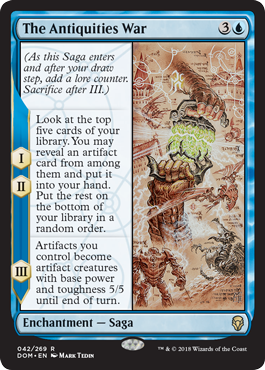
This Saga represents the war between Urza and Mishra that was first talked about in the Antiquities expansion. In it, the two brothers used an army of artifact creatures that they excavated and fixed from a past civilization (called the Thran, thus "antiquities") to wage war against one another. This Saga tries to capture this by having you attack your opponent with an army of artifacts. As with many of the Sagas, the design is to have the first two chapters set you up for a dramatic third turn in the final chapter.
The real question most players have about this card is why the war is called the Antiquities War rather than the Brothers' War, the name most players know it by. There were a few reasons. First, in world, most denizens of Dominaria refer to it as the Antiquities War. Second, we tried to use the naming to help players less familiar with the past have a sense of where the story came from. Using actual expansion names was the easiest way to help people place things. Third, the word antiquities helps convey the artifact flavor of the card.
One other interesting note was that we had Mark Tedin illustrate this card. Mark's work goes all the way back to Limited Edition (Alpha), and he actually even illustrated a card in Antiquities (Priest of Yawgmoth).
Blackblade Reforged
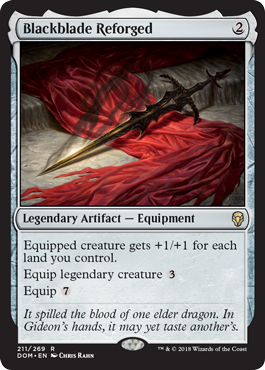
During our very first Dominaria vision design meeting, I asked the question, "What will players expect to see in the set?" We all knew it was going to have a nostalgia element, so I wanted to get all the expectations we'd be dealing with on a whiteboard. With more than 30 sets to pull from (including the expansions set on Rath, which got overlaid onto Dominaria), there were inevitably going to be way more things that could be in the set than would actually end up in the set. One of the first items called out was the Blackblade.
For those unfamiliar with the Blackblade, its origins go all the way back to the 1994 set Legends. In it, we met a man named Dakkon Blackblade.
Dakkon forged a mighty sword that drained the life essence from every creature it killed. The power of the sword was reflected in Dakkon's stats (power and toughness), which were each equal to the number of lands you controlled. The Blackblade got referenced many years later in Future Sight with a future-shifted card called Korlash, Heir to Blackblade. Korlash's power and toughness were also tied to how many lands his controller had, although Korlash only cared about Swamps.
The reasons we were excited to show the sword rather than another person wielding it were twofold: one, we now had Equipment as a card subtype, so we could let your creatures wield the Blackblade, and two, even though we hadn't yet landed on the theme of history, we understood that we wanted Dominaria to be a world where many things called back to the past. In addition, one of my concerns was making sure that newer players who wouldn't know of the history could appreciate the items in context. A powerful sword is cool even if you don't know its history.
The design was straightforward. It grants the equipped creature the same bonus Dakkon had back in the day—increasing its stats by the number of lands you control. The one new element we added was the idea that the sword wanted to be wielded by someone special, so we made it easier to equip to legendary creatures. We tried a bunch of different executions, but finally settled on a new templating "equip _____." I'm excited by the flavorful things we'll be able to do with this template in the future. We talked about making it only equippable to legendary creatures, but decided it wouldn't be fun to draw it and never get to equip it because you haven't drawn any of your legendary creatures yet.
Also, I recommend you read the Dominaria story, because the Blackblade plays a role (the flavor text might give you a hint about that).
Blessing of Belzenlok
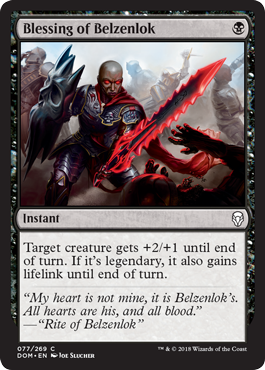
The card was one of the designs that helped us clarify when to reference legendary as opposed to referencing historic. I believe the earliest version of this card said legendary, but it was changed to historic because legendary is just a subset of historic. The set had some artifact creatures, so by changing this to historic, we were allowing it to hit more targets.
But when people playtested it, we found that referring to historic creatures confused them because it only referred to a subset of historic cards (artifact creatures and legendary creatures—okay, and animated Sagas, which was not something that could be done within Dominaria). Having to figure out which subsets counted proved more taxing than we wanted, so we changed it back to affecting legendary creatures. We then made a rule that said if something wants to just affect creatures, we'd say legendary creatures rather than historic.
Broken Bond
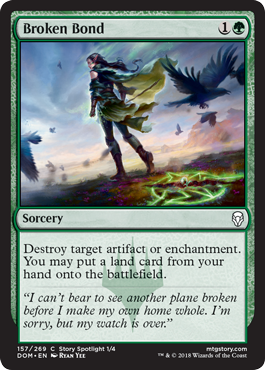
One of the consequences of the Gatewatch's defeat at Nicol Bolas's hands was Nissa making the decision to leave the Gatewatch. Once this was decided story-wise, we wanted to find a card to show this breaking of the oath. We knew it had to be a green card, as it was Nissa. We also wanted to find some mechanical way to nod toward the oath being broken. The solution came when we realized all the Oath cards had been enchantments. What if this card destroyed enchantments? Thus, it could literally break an Oath. As this was green, we put the effect on a Naturalize (destruction of artifact or enchantment). Then, to get a little feel of Nissa on it, we added a rider of getting a land because Nissa is so strongly associated with land. And that is how we told the sad story of Nissa leaving the Gatewatch.
Chainer's Torment
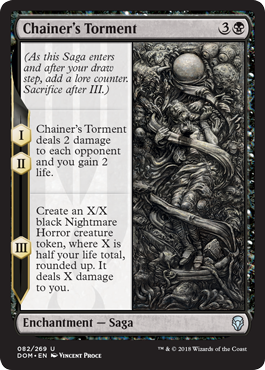
This Saga's title is making two different references. First, it's making a reference to Chainer, a character from the Odyssey block story. Chainer was a member of the Cabal and became friends with Kamahl, the protagonist of Odyssey. The title also references Chainer's Torment, the novel for the Torment expansion in which Chainer is the main character.
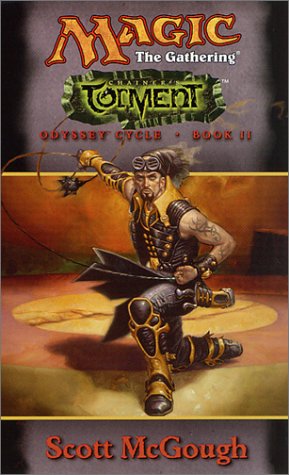
In vision design, we made a bunch of Sagas to demonstrate how we wanted them to work. Then, during set design, Kelly Digges, as the story liaison, figured out what stories they wanted the Sagas to represent. Each of the fourteen Sagas tells a story from Dominaria's past that has previously been referenced elsewhere, making each one an Easter egg for players familiar with the earlier story.
I believe this design was one of the ones made before we knew what the stories were. The idea behind it was that you spent the first two chapters building up a resource (your life total) that you then used during the final chapter. Kelly wanted to reference the Odyssey storyline, and this card seemed like a good fit. The name was a fun reference to the book.
Danitha Capashen, Paragon
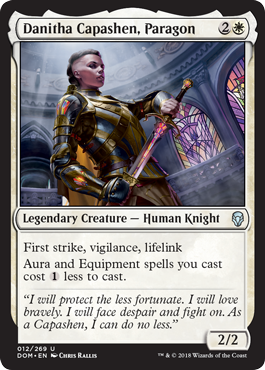
When we made the whiteboard list during our first vision design meeting, we included not only things we wanted to reference directly but also things we wanted to touch on more indirectly. One of those things was the descendants of famous characters from Dominaria's past. Yes, there were characters like Teferi, Karn, Jaya, and Jhoira who were still around, but a lot of famous characters had died. During Future Sight, when we were trying to find ways to make future-shifted cards that showed a potential future but hinted at the past, we came up with the idea of making descendants. That worked so well, we knew we wanted to do it again with Dominaria.
So we made a list of all the different characters it would be fun to reference. One of them was Gerrard Capashen, the protagonist of the Weatherlight Saga, a story that ran through four years' worth of sets. The problem was, Gerrard died and never had any children. We came up with the idea of carrying on the Capashen lineage even if it wasn't directly descended from Gerrard. The name Capashen itself would carry nostalgia. The Capashens were already tied to Benalia, but we tied them together further in the worldbuilding.
The goal behind Danitha was to make a creature you wanted to enchant or equip. To do that, we first gave her a bunch of abilities that would work well with power boosts. Next, we gave her an ability that made it easier to enchant and equip her. The card was put at uncommon because we felt it was a fun build-around card for Draft.
The reason she's legendary and an uncommon is because historic (artifacts, legendary things, and Sagas) was a main theme, so we wanted to make sure the as-fan (how many cards of a particular type you get on average if you open a booster pack) was high enough to matter.
Daring Archeologist
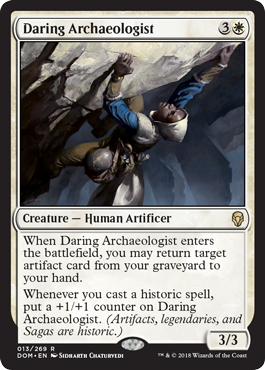
When I was given the task of designing some resonant historic cards, this was the first card I designed. I think the playtest name was Raider of Tombs. There was some talk about whether it was okay that one ability affected only artifacts while the other on the same card referenced historic. Shouldn't the two be lined up? I argued no, because I thought the flavor worked better with them being different. The archeologist recovers specific artifacts, but is still a student of broader history. This card ended up very close to how I first designed it.
Demonlord Belzenlok
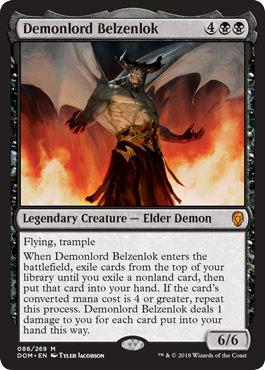
To stave off death and gain eternal youth, Liliana made a contract with four demons (Kothophed, Griselbrand, Razaketh, and Belzenlok). We met her second demon (in the order she offed them), Griselbrand, in Avacyn Restored. She had him freed from the Helvault so she could kill him. We then met her first demon, Kothophed, in Magic Origins. He also died at her hand. Next, we met her third demon, Razaketh, in Amonkhet. Liliana finished off Razaketh with some help from the Gatewatch. Dominaria holds her fourth and final demon, Belzenlok. He's not just any character, though—he's the main antagonist of Dominaria. That meant we had to make him a sweet card.
Before I get to that, though, there's a quick thing I need to talk about. Often in Magic, we make a pattern without meaning to do so. Liliana's four demons are a perfect example. Kothophed, the first demon Liliana killed, was a 6/6. Griselbrand, the second to die at her hand, was a 7/7. Razaketh, third to go, was an 8/8. I think you can see where this is going. If we followed the pattern, Belzenlok would be a 9/9. I should stress that we never set out to make a pattern. We didn't even design them in chronological order of their deaths. We talked about continuing with the pattern, but one of our goals was to make Belzenlok a strong card, and it's difficult to properly cost a 9/9 and still make it tournament relevant. After some discussion, we decided to abandon making him a 9/9.
Belzenlok, as a character, is obsessed with knowledge, so we knew we wanted to have him interact with drawing cards. He's a demon, though, so we also knew it had to be something that would most often be beneficial for you but had the potential to go wrong. We ended up coming up with a card drawing mechanic that had the ability to burn you. The cool thing about it was you had some ability to build your deck in a way that mitigated how risky you wanted to be. We then made him a 6/6 and gave him flying and trample to help cement the Demon flavor.
Dub
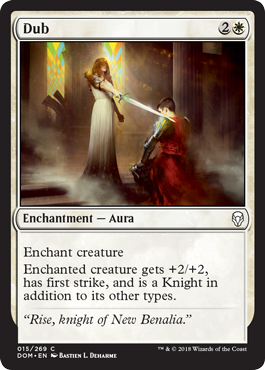
Dominaria's code name was Soup. When we were designing it, it was originally going to be followed by Salad, a small expansion also set on Dominaria. So, during vision design, we not only worked on Dominaria; we also set up what we wanted Salad to be. I'm not going to go into great detail about what Soup was going to do because I have confidence we'll find homes for a lot of the material in future sets, but there was one theme that impacted Dominaria's design, so I'm going to talk about it here.
One of the elements we were going to focus on in Salad was a battle between the forces of good (the Gatewatch and their allies) and the forces of evil (Belzenlok and his minions). We recognized that there was some mirroring, as the high-fantasy flavor of Dominaria meant that both sides would have Knights. To play on this, Salad had a Knight tribal theme.
When Salad turned into Core Set 2019, we ended up pulling a tiny touch of the Knight tribal (I believe the set has two cards that care about you having Knights) into Dominaria. Dub isn't technically Knight tribal as it only makes something into a Knight (it doesn't care if you have other Knights), but it was created to be in a set where being a Knight mattered a bit more. We talked about taking the rider off, as Knight tribal was no longer going to be a big theme, but the flavor was so perfect (as was the name) that we left it alone.
The Eldest Reborn
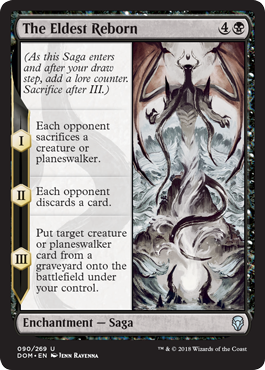
We wanted to use the Sagas to tell Dominarian stories. It turns out one of those stories plays into the larger story going on with Magic. The Eldest Returns tells the story of Nicol Bolas's death and resurrection. Usually when I say this, the response I get is "Nicol Bolas died?" He did. (Okay, kind of. It's complicated.) This Saga tells the story of Bolas's return.
The design started with the third chapter. It put a planeswalker from a graveyard onto the battlefield. That felt a little narrow, so it was changed to return either a planeswalker or a creature. This allowed us to make the first chapter an effect that forced all opponents to sacrifice a creature or planeswalker, mirroring the third act. First chapter, Bolas dies. Last chapter, he returns. Chapter two needed to be a black effect that tied into one of the other two chapters. Discard works well because if your opponent discards a creature or planeswalker, you can put it onto the battlefield on your next turn.
One Down, Two to Go
That's all the time I have for today. As always, I'm eager to hear your feedback on today's article as well as the set of Dominaria as a whole. You can email me or contact me through any of my social media accounts (Twitter, Tumblr, Google+, and Instagram).
Join me next week for part two.
Until then, may Dominaria provide you with many stories of your own.
#527: Dissension, Part 2
#527: Dissension, Part 2
I finally get around to the third and final set in original Ravnica block, Dissension. This is part two of three, where I share many card-by-card design stories from the set.
#528: Dissension, Part 3
#528: Dissension, Part 3
I finally get around to the third and final set in original Ravnica block, Dissension. This is part three of three, where I share many card-by-card design stories from the set.
- Episode 526 Dissension, Part 1
- Episode 525 Rookie Mistakes
- Episode 524 GDS3, Trial 3




